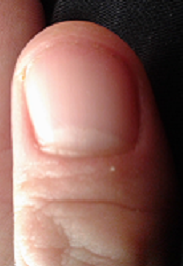
Description
Fingernails and toenails are made of a tough protein called keratin as are animals' hooves and horns. It is a horn-like structure located at the end of fingers and toes forming flat plates. Each nail is composed of a root and body. The root fastens the nail to the finger or the toe by fitting into a groove in the skin and is closely moulded to the surface of the dermis. The only living part of a nail is situated inside or underneath the epidermis. Nails act as a counterforce when the end of the finger touches an object, thereby enhancing the sensitivity of the fingertip. Average growth is 1 millimetre per week. A fingernail or toenail takes about 6 months to grow from base to tip.
Function
A healthy finger nail has the function of protecting the distal phalanx, the fingertip, and the surrounding soft tissues from injuries. It also serves to enhance precise delicate movements of the distal digits through counter-pressure exerted on the pulp of the finger. The nail then acts as a counterforce when the end of the finger touches an object, thereby enhancing the sensitivity of the fingertip, even though there are no nerve endings in the nail itself. Finally, the nail functions as a tool, enabling for instance a so-called "extended precision grip" (e.g. pulling out a splinter in one's finger).
Colour
Mostly clear
Shape
Like fish scales.
Location
Ends of Fingers & Toes.
Fingernails and toenails are made of a tough protein called keratin as are animals' hooves and horns. It is a horn-like structure located at the end of fingers and toes forming flat plates. Each nail is composed of a root and body. The root fastens the nail to the finger or the toe by fitting into a groove in the skin and is closely moulded to the surface of the dermis. The only living part of a nail is situated inside or underneath the epidermis. Nails act as a counterforce when the end of the finger touches an object, thereby enhancing the sensitivity of the fingertip. Average growth is 1 millimetre per week. A fingernail or toenail takes about 6 months to grow from base to tip.
Function
A healthy finger nail has the function of protecting the distal phalanx, the fingertip, and the surrounding soft tissues from injuries. It also serves to enhance precise delicate movements of the distal digits through counter-pressure exerted on the pulp of the finger. The nail then acts as a counterforce when the end of the finger touches an object, thereby enhancing the sensitivity of the fingertip, even though there are no nerve endings in the nail itself. Finally, the nail functions as a tool, enabling for instance a so-called "extended precision grip" (e.g. pulling out a splinter in one's finger).
Colour
Mostly clear
Shape
Like fish scales.
Location
Ends of Fingers & Toes.
 RSS Feed
RSS Feed
